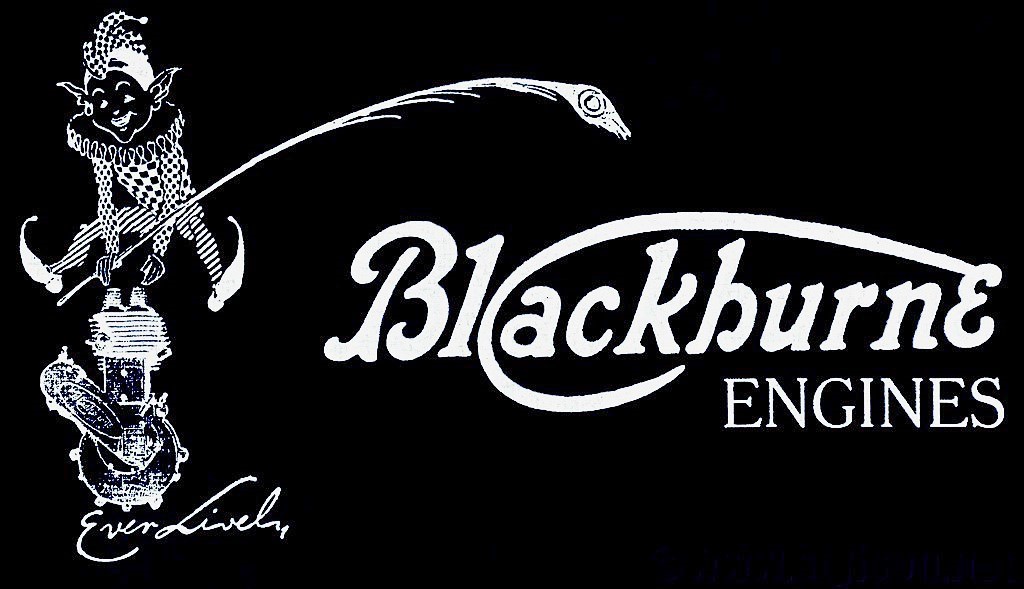HISTORY
Blackburne was a trade name of Burney and Blackburne Limited a British manufacturer of motorcycles from 1913 to 1922 at Tongham near Farnham, Surrey. They were also a major supplier of engines to other motor cycle and light car makers and continued to make these until 1937. Burney and Blackburne also made small aircraft engines.
The origins of the Blackburne motorcycle engine can be traced back to Geoffrey de Havilland who had designed (and made) a motor cycle before he became fascinated with aircraft. He sold the designs and patterns to two student friends for £5 when short of money in c1905, and they went on to form the Blackburne engine company.

A patent for adjustable belt pulleys for motorcycles dating back to 1912, shows Cecil Stanley Burney, Edward Alexander (Alec) Burney, and pioneer aviator Harold Blackburn trading as Burney and Blackburne (not Blackburn), operating from Northchurch, Berkhamsted. They were incorporated shortly afterwards as Burney and Blackburn Ltd, at which point Harold Blackburn sold his stake to the competition riders Cecil and Arthur Roberts. As a “dividend” for his investment, Blackburn was given a motorcycle and sidecar from the original production batch. Harold Blackburn used this machine to promote flying displays in Yorkshire.
Production moved to Tongham, Surrey shortly after incorporation, and they remained there throughout the war, but adverts for their engines from 1922 show a change of address to Atlas Works, Bookham, Surrey. This was the year motorcycle production ceased, and the main focus became engine manufacture. The Atlas works was 56,000 square feet by the end of the war, and is the subject of research by P. Taplee of the local history society.[4] Although there are reports of a link with Osborn Engineering Company (OEC), these were most likely just another customer for Blackburne engines.
Blackburne motorcycles performed well in the 1913 and 1914 ACU six days trials. Three 499cc Blackburne motorcycles were entered in the ACU six days trial in 1914 one ridden by John Spear Roberts (ex Motosacoche Ltd), who is named as joint applicant in a Blackburne patent of 1918. In the judges summary of the event they stated that the “Blackburne machines are also worthy of very favourable notice on account of their good engine design”. With the outbreak of the war in mid-1914, three directors of Burney and Blackburne Ltd volunteered as despatch riders, these were Cecil Burney, Alec Burney and C.Q. Roberts (also Q.A.Roberts his brother). Reporting back to the Motor Cycle later that year, Alec Burney had lost his machine when it was run over by the heavy artillery during the night. Reporting in November Cecil Burney stated that his Armstrong (hub gears) were standing up wonderfully well, but was adamant that a hand clutch (instead of the common foot clutch) was an absolute requirement. In November 1916 it was reported that the Burney brothers had received lieutenant’s commissions, Alec running a motor cycle repair base in France, and Cecil running a repair shop for engine-driven electrical lighting units for a signals station.
After the 1914-1918 war Blackburne became a major supplier of engines to motor cycle manufacturers. Some of these included, Cotton, Wolf, Excelsior, Victoria, New Scale, Verus and Sirrah, Rex and Rex Acme, Wilkin, Hoskinson, Chater Lea and OK Supreme

This list is far from complete, as research from the local history society using records at the National Motor Museum, Beaulieu discovered “11 aircraft manufacturers, 70 motor cycle makers, 24 car makers, 2 fire appliance makers, 3 agricultural machine makers and 7 lawn mower firms, all of whom used Blackburne engines built at Bookham”.
That Blackburne managed to secure so many customers for their engine in a few years after the war is a tribute to how well the engine was regarded, not least because of its excellent competition performance. The number of companies reflects the huge demand for motorcycles, although many of the companies survived only until the great depression of 1929/1930. However, in their 1932 engine catalogue Blackburne stated they were “exporting engines in large numbers to France, Belgium, Germany, Sweden, Italy, Japan, etc where they are fitted by some of the largest and best known manufacturers of quality machines”.
Blackburne engines were favoured by several manufacturers for the TT races from 1920, competing mainly against J.A.P. engined rivals in the lightweight (250cc) class, and against A.J.S. engines in the Junior (350cc) class. In the 1920 Junior TT Blackburne bikes came 2nd and 3rd. In the 1922 Lightweight TT Blackburne-engined bikes were second (Rex-Acme), fourth (Sheffield-Henderson), seventh (OK-Supreme) and ninth (Coulson), and in the Junior TT they were third (Sheffield-Henderson), fourth (Coulson), fifth (Cotton), eighth (Edmund) and ninth (Blackburne). Stanley Woods on the Blackburne-engined Cotton won the 1923 Junior TT.
Between 1923 and 1930, riders Norris, Harold Beart and Jackson achieved considerable success with Blackburne KMA, KMB racing engine and KMC sports engine powered machines.
Around 1922 Blackburne moved into aviation with their Tomtit two cylinder light aircraft engine based on the 696cc Lympne V-twin. They continued developing new and larger aircraft engines until 1926
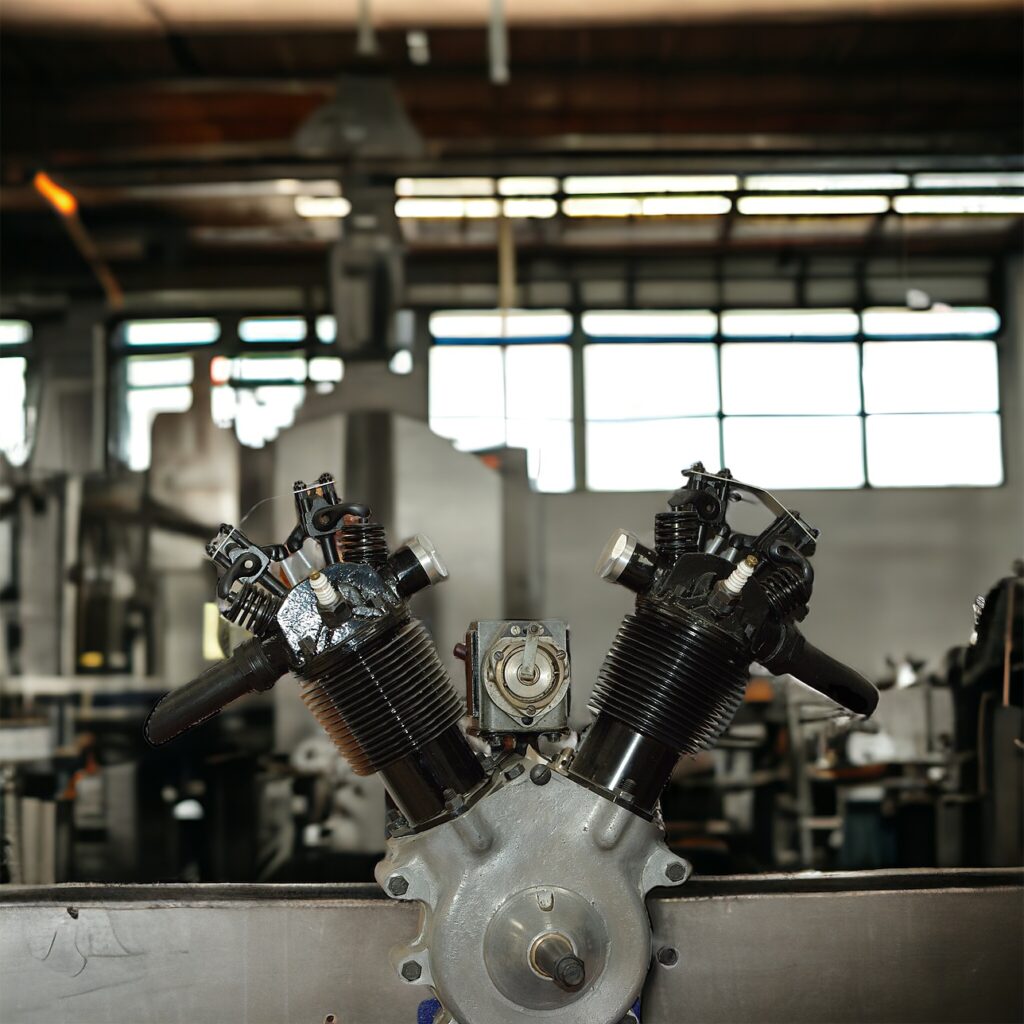
The Piston Engine Revolution
M W Vincent
Blackburne engines were initially produced for motorcycles from 1912. The
fairly simple side valve (SV) design with external flywheel continued into the
early 1930s, although overhead valves were adopted on some engines in
the early 1920s. V-Twin and three cylinder radial engines were produced
for light aircraft following Blackburne’s participation in the 1923-1926
Lympne air trials. Motorcycle engine production expanded during the 1920s
with a wide model range, and significant commercial and competition
activity. V-twin engines were used in Morgan three-wheelers and other light
cars. About 1930 the engine range expanded further with the production of
a sophisticated engine for the luxury small car market. A 1500cc single
overhead camshaft (OHC) six cylinder engine was produced in 1932 for the
Invicta car company, while in 1933, a development of this engine led to a
twin OHC high performance unit of either 1500 or 1667cc for Frazer Nash
sports cars. The larger capacity engine was guaranteed to produce 75bhp.
These engines exhibited a number of quite advanced design features for
the time. However, relatively few were produced, and in 1937 the company
ceased engine production, concentrating on military and aircraft contracts
ahead of the impending Second World War.
Blackburne, Motorcycle, V-Twin, OHC, Six-Cylinder
The Beginning
The origins of the Blackburne saga can be traced to the wellspring of ‘The English
Mechanic and World of Science’ magazine.1 The first article in a series which
described how to build a motorcycle appeared on 4 January 1901, and from then
until mid-April 1901, the construction of every part of its single cylinder engine
was described in laborious detail. Figure 1 shows the assembled engine.
All parts of the engine, including the ignition system, carburettor, exhaust
system and a combined epicyclic clutch/brake gear reduction unit, were described
in enough detail to permit the construction of the engine for use in a motor bicycle,
as it was described. The engine was of simple design, and reflected contemporary
practice. It featured an automatic inlet valve, opened through suction on the
induction stroke, and a mechanically operated exhaust valve, actuated by cam and
pushrod. The cast iron cylinder barrel was finned for cooling, four bolts retaining
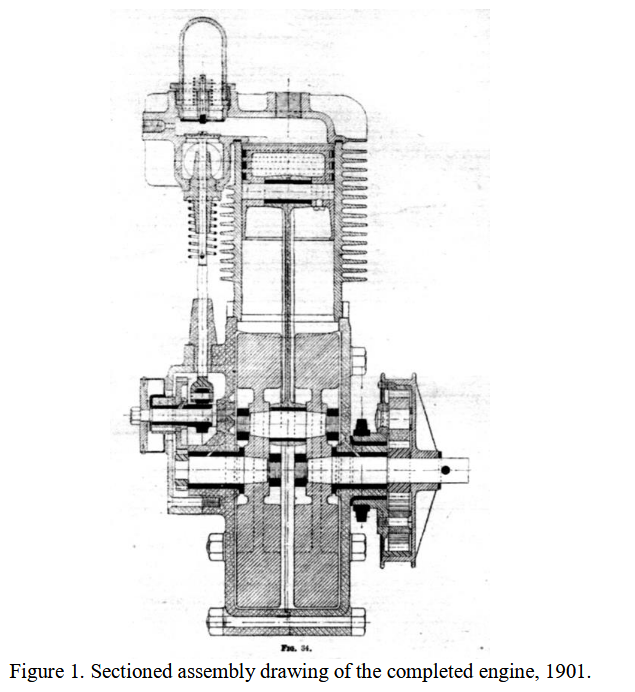
Both the head and barrel on to the crankcase. The cast iron piston had three plain
cast iron rings. The intake pipe and automatic inlet valve on top of the cylinder
head, and the pushrod operated side exhaust valve are shown in Figure 1, which
also shows the internal flywheels, and the connecting rod. Drive was taken from an
externally mounted chain sprocket.
The crankcase, which comprised two light alloy castings bolted together,
housed a pair of cast iron flywheels with an offset pin forming the crankshaft. Each
flywheel casting featured a balance weight opposite the crankpin, a refinement not
universal at this time. The crankshaft/flywheel assembly was of built-up design,
allowing the use of a malleable cast iron connecting rod with a plain ring at both
little and big ends, into which brass bearing surfaces were fitted. Both bore and
stroke were 63.5mm (2½ inches in the design), giving a capacity of about 200cc.
The compression ratio was unstated, but a value of about 3.5:1 may be calculated
from dimensions in the cylinder head drawings, consistent with the low octane
quality of available spark ignition fuels (typically 45-60 octane). The engine was
rated at 1.5 horsepower, with speeds of up to 2000rpm mentioned, perhaps optimistic by 1901 standards. With a surface carburettor, atmospheric inlet valve and heavy cast iron piston, maximum engine speed would probably have been
about 1200 to 1500rpm, and it seems unlikely that the unit would have produced
much more than the rated power.
It is not clear how many English Mechanic readers actually produced
motorcycles of their own using these detailed instructions, but one who did was
Geoffrey de Havilland, famous later as the founder of the de Havilland aircraft
company. Geoffrey, later Sir Geoffrey, was a student at the Crystal Palace
Engineering School from 1900. In 1902, as a special project forming part of the
course, he produced a motorcycle using the English Mechanic drawings. After
constructing and using the machine, de Havilland decided on a number of
improvements, and went on to build a 450cc engine of his own design, claiming
several original features. This latter engine was constructed in 1903, after he had
started an engineering apprenticeship with Willans and Robinson of Rugby.
The engine de Havilland designed was materially different in a number of
important respects, but drew from his experiences with the English Mechanic
engine. Key differences were the significantly larger cubic capacity, the novel use
of a mechanical inlet valve in place of the suction operated device, and an external
flywheel of some 12 inches (305mm) diameter. This latter feature allowed the use
of a one-piece crankshaft, with split and bolted connecting rod, more typical of
passenger car practice. The connecting rod was cast in phosphor bronze. Instead of
cooling fins, copper wire was coiled around the outside of the cylinder barrel. On
this engine a yoke to retain the valve caps also served to attach the cylinder barrel
and head to the crankcase, via two long clamp-bolts. Furthermore, a single-jet
spray carburettor with needle valve and butterfly throttle replaced the surface
carburettor of the English Mechanic design, while ignition was by trembler coil
with wipe contact. Compression ratio was 4:1.3 De Havilland designed and
commissioned a frame to complete the motor cycle.4
The Burney Brothers
With its relatively large 450cc engine, the motorcycle was judged a success, and in
due course passed on to de Havilland’s younger brother Hereward. In 1903 two
fellow students at Willans and Robinson, brothers Cecil and Alick Burney, were
also impressed with de Havilland’s motorcycle. When de Havilland was
temporarily embarrassed for funds, the Burney brothers bought a set of engine
castings and patterns for the proverbial fiver.5 This was a fair sum at the time,
equivalent to roughly a month’s wages for a working man. The Burney brothers
used de Havilland’s design, patterns, and spare castings, to build an engine in the
Willans’ works, apparently with management consent. The completed engine was
then fitted into a locally made cycle frame, for use in sporting trials and other similar events. C.S. Burney was particularly active and successful in trials with his
motorcycle, establishing quite a reputation.
From about 1904 the engine design inherited from de Havilland was
subjected to sustained development and testing by the Burney brothers in
competitive motor cycle trials and related events, over a period of about seven or
eight years. In 1907 a new design of cylinder head having sloping inlet and exhaust
ports was adopted, while a more conventional finned cylinder barrel replaced the
copper tube design. Cecil Burney won the Schulte Cup for the best performance in
the open class of the Coventry MC 100 mile trial in August 1907 with this engine
in his motorcycle. More development followed; by 1909 overhead inlet valve
cylinder heads and magneto ignition were in use on both brothers’ motorcycles.
Success followed at Aston Clinton hill climb and at other similar events.
Harold Blackburn and the Formation of the Company
In 1912, the Burney brothers, then living at Northchurch near Berkhampsted,
decided to go into business on their own account as motorcycle manufacturers. The
engine they employed had been developed and proven from the original 1903 de
Havilland design. A partnership was formed between the Burney brothers and
Harold Blackburn, a pioneer aviator whom Alick had met at Hendon.10 Early in
1911, Harold Blackburn was learning to fly at Hendon, but transferred to
Brooklands, where he gained his Royal Aero Club Certificate.
Alick was working for Godfrey and Nash in the spring of 191112 just as manufacture of the GN cycle car commenced in Hendon. Both Ron Godfrey and Archie Frazer-Nash had also served apprenticeships at Willans and Robinson, starting in about 1906 .
Harold Blackburn put up the sum of £200 as capital for the Burney brothers’
venture. Initially, production was sufficient to produce three machines, which were
built by Charles Southey who was running a cycle business in Berkhamsted,
established late in the nineteenth century. The capital provided by Harold
Blackburn was used to manufacture three motorcycles with SV engines. The single
speed belt-drive machines were assisted by the use of a large external flywheel as
on the de Havilland engine.
Contemporary records give a good account of the new Blackburn motorcycle
(‘Blackburn’ at this time was spelled with no ‘e’). In January 1913, the engine was
rated at 3½ hp18 and described as being the result of nearly ten years’ experiment.
Bore and stroke were 85mm x 88mm respectively, with a detachable head and side
by side valves. The cylinder head was retained by three long bolts that also secured
the barrel to the aluminium crankcase, a departure from the yoke and two bolts
employed by de Havilland. The crankshaft was a one-piece forging with balance
weights riveted in place. Phosphor bronze main bearings were employed, with white metal big end bearings in a split-connecting rod. The piston, described as
light in weight, had two piston rings. It had an oil groove at the bottom of the skirt,
which dipped into a trough at its lowest point, flinging oil on to the cylinder walls.
Both valves were operated by the same cam, using rocker-type followers, the
Bosch magneto being driven from the end of the camshaft.
In September 1913, a Blackburn motorcycle won a gold medal in the Six
Days Trial.19 About this time, the Burney brothers decided to form a company,
Burney and Blackburn Ltd, together with the Roberts brothers, Cecil and Arthur.
Although the company bore Harold Blackburn’s name, he decided about this time
to pursue his main interest in aviation. The split was quite amicable, Harold
retaining a Blackburn motorcycle and sidecar outfit.20 About two months later,
Burney and Blackburne (now spelled with an ‘e’) took stand number 41 at the 1913
Motor Cycle show in London,21 having moved to new and larger premises in
Tongham in Surrey. The factory was close to the ‘Hog’s Back’ road, which formed
a useful test track for the company’s products. In 1914 production of Blackburne
motorcycles continued with detail improvements, but essentially the engine
remained as developed by the Burney brothers from de Havilland’s original
design.
World War I and Wartime Development
The outbreak of war in August 1914 had a profound effect on the infant company,
as four of the five founder members signed up for the army at the outset. With the
departure of Harold Blackburn the previous year, none of the originators remained.
The Roberts brothers’ father, G.Q. Roberts, took over the management of the
company, while veteran TT rider J.S. (Jack) Holroyd took up the post of works
manager.23 Completed motorcycles were commandeered for the war effort, with
further commercial production suspended. However, engine development
continued for the early war years, with detail improvements.24 A racing machine
was under development,25 improved valve cooling, steel crankshaft balance
weights, and better port design were proposed for the 1916 models.26 This latter
suggestion was probably wishful thinking, given the continuing hostilities. The
500cc SV engine described in 1917, and shown in Figure 2, remained the only
model.27 The 500cc Blackburne engine, with its substantial external flywheel, has
a significant visual impact. Figure 3 below shows the cylinder barrel with its three
stud fixing, and grooves in the fins to accommodate the studs, which also retained
the cylinder head. 28
Figure 4 shows the crankshaft and connecting rod assembly, plus the cam
follower rockers that actuated the valves via push rods. The big end design
included an oil scoop for bearing lubrication.
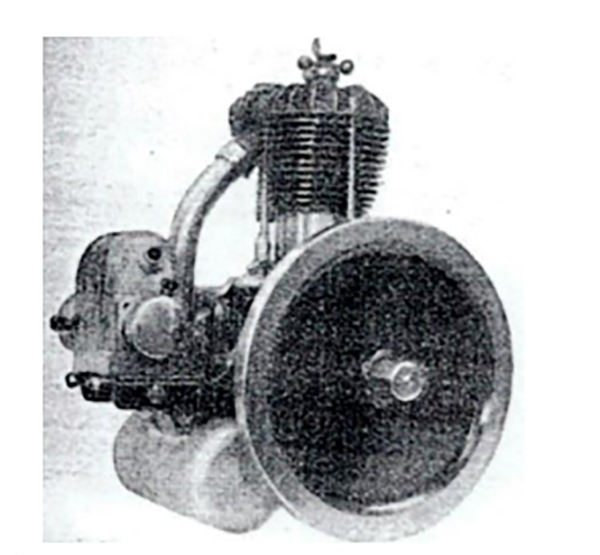
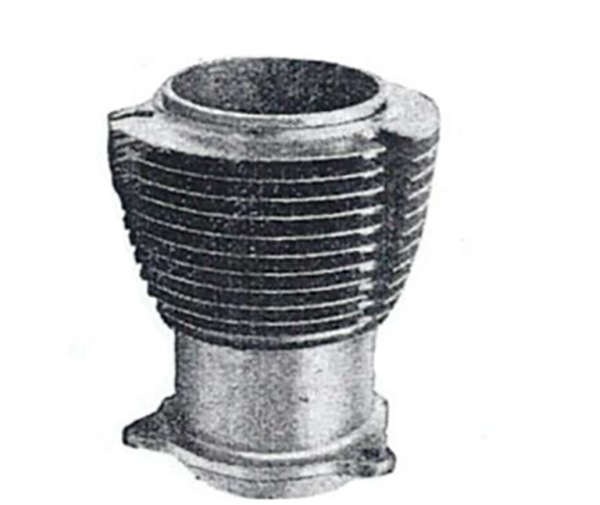
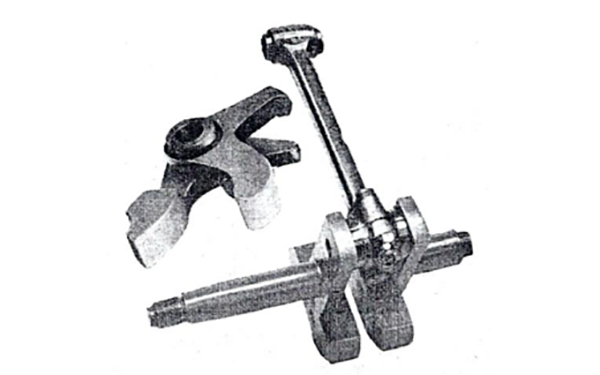
Despite wartime munitions work, some motorcycle development activity
clearly continued. In January 1918 news emerged of a new V-twin engine of one litre nominal capacity designed by Jack Holroyd.30 The engine employed the single
cylinder 85mm bore and 88mm stoke dimensions. A very significant number of
parts were common to the older design, which minimised new work during the war
years, the cylinder barrel, for example, being unchanged for the V-twin design. The
crankshaft also appeared outwardly similar, but was in fact fabricated in two parts.
The crank pin and one half of the crank throw, together with one main bearing
shaft, were machined from solid and case hardened. The crankpin was bolted
through the other half crank throw to complete the assembly. This arrangement
allowed assembly of the connecting rods on to the crank pin. Whereas the single
cylinder engine employed a split big end bearing design with white metal lining,
the V-twin connecting rods were of one piece, with circular big end bearing
housings into which hardened 5/16 inch rollers were inserted. One connecting rod
was forked, allowing the other rod to fit inside on the common crankpin. Figure 5
shows the new V-twin engine described in January 1918. 31
This engine was intended to appeal to owners of motorcycle and sidecar
units, increasingly popular with the family man. An additional application was the
so-called cycle car, production of which began before the war. Demand
mushroomed in the immediate post war boom, with pent-up demand for motor
transport briefly at an all-time high. Typical of the cycle cars that catered for this
demand were the GN and the Morgan three-wheeler. A description of the 1919
Blackburne models givesuseful information on the available engines, including
their valve timing.
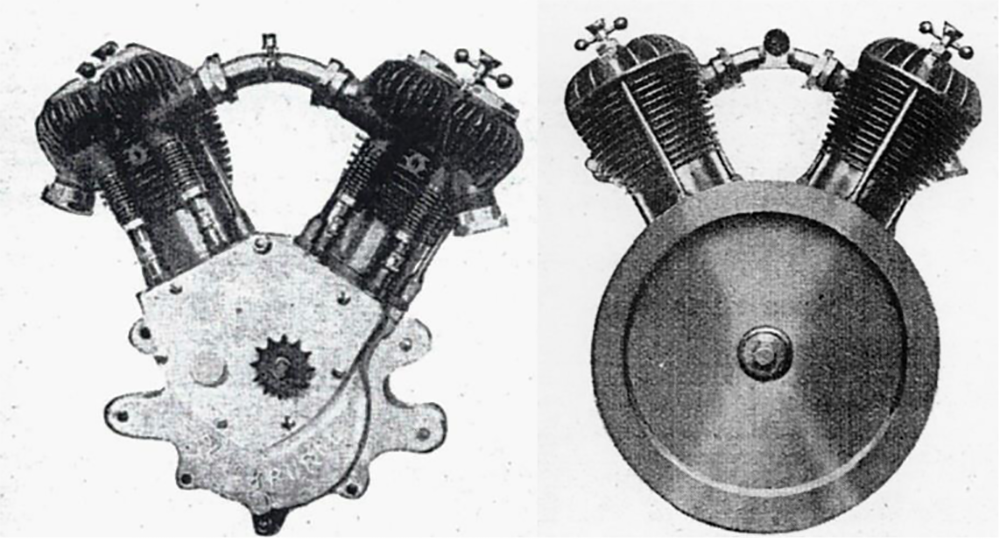
Both single cylinder and V-twin engines shared the same cam profile and
valve actuation method, with both valves operated from a single cam via rocking
followers inside the timing chest. Valve timing for Blackburne engines at this time
is given in Table 1 below:

The conservative late opening of the inlet valve and minimal valve overlap
would have limited both engine speed and power output. However, Blackburne
engines had built up an enviable reputation for reliability, ease of maintenance and
sustained service. The relatively large capacity lightly stressed design concept had
provided similar virtues in Victorian steam engines. The clearly stated Blackburne
design policy also makes interesting reading:
In order to simplify the spare parts problem all Blackburne engines have been
designed with the maximum number of parts interchangeable with all types;
thus the pistons for the 4hp and 10hp engines either air or water cooled, are
made to the same specification and drawing.
Henry Hatch
Whilst this approach did have significant benefits, it may have disguised a
reluctance to innovate, possibly due to the loss of the company founders who
developed a sound and reliable engine initially. The exodus of design inspiration
when the Burney brothers joined the army in 1914 was not made good when they
returned to the UK; neither brother rejoined the company. However during 1918,
Henry J. (Harry) Hatch joined the company as designer, following which
significant design changes were evident. In 1913 Hatch was head of the
experimental department with J.A. Prestwich (JAP) in Tottenham. When Hatch
joined Blackburne and Burney Ltd. there were just two engines in the company
portfolio, the 500cc single and 1000cc twin. Hatch was influential in
transforming the engine range through the pursuit of racing and record breaking
success, which became a notable feature for Blackburne engines in the 1920s and
beyond.
An expanded engine range was evident early in 1919.38 Single cylinder
engines were now available in two different sizes rated at 2¾hp and 4hp, together
with 60 degree V-twin engines of 8hp and 10hp. The 2¾hp (348cc) and 4hp
(499cc) singles shared a common stroke of 88mm, with bores of 71mm and 85mm respectively, while the 8hp (998cc) and 10hp (1098cc) V-twin engines shared a
common bore of 85mm with strokes of 88mm and 96.8mm respectively. The 10hp
V-twin engine was available with both air and water-cooling. All engines were of
SV design, retaining the famous Blackburne external flywheel across the extended
range. These engines were offered to other manufacturers for their machines, in a
bid to increase sales. In 1921, manufacture of Blackburne motorcycles was
transferred to the Osborn Engineering Company (OEC) of Gosport, Burney and
Blackburne concentrating solely on engine manufacture.
Gillett and Stephens
Gillett and Stephens’ management, after a merger with Burney and Blackburne in
1921, took a decision to concentrate on engine manufacture. In effect, Gillett and
Stephens took control of Burney and Blackburne Ltd, staff transferring to the new
organisation including Harry Hatch. The transfer from Tongham near Aldershot to
Great Bookham close to Leatherhead represented more than just a geographical
relocation. Hatch, who now controlled both experimental and design departments,
seems to have enjoyed his new management’s confidence.40
The policy adopted was one of experimentation, frequently involving
racing and other competitive activities, including record breaking at nearby
Brooklands track. Successful designs would then form the basis for engines offered
commercially. This policy resembled the approach adopted by the Burney brothers
during the years from 1904 to 1913. New designs to emerge in 1922 were the
350cc overhead valve engine, and a comprehensively revised fixed head SV engine
of 250cc capacity.41
The SV engine, capable of almost 5000rpm, broke records at Brooklands in
1922, covering nearly 62 miles in the hour in an OK Junior motorcycle, and
sustaining over 56mph for seven hours.42 The new 350cc OHV engine featured
inclined overhead valves operated by pushrods, permitting the classical
hemispherical combustion chamber shape featured in many racing engines.43 This
engine is shown in Figure 6.
The OHV 350cc engine borrowed its bore and stroke (71mm x 88mm
respectively) from its SV cousin, but employed dramatically different valve timing,
combustion chamber shape and port design. To reduce valve train stresses, push
rods were angled inwards towards each other at their upper ends. The OHV unit
employed the SV single cam design, using two rocker-followers inside the
crankcase. The engine was normally fitted with a cast iron piston, and still
employed the trademark external flywheel, evolution rather than revolution being
apparent at this stage. Valve timing, for the new OHV engines, giving forty degrees
of valve overlap, is shown in Table 2

Alive to the benefits of competition success, the company sold a racing version of
the 350cc OHV engine, with light alloy piston, higher compression ratio and racing
cam. Also emerging in 1922 was an OHV version of the 700cc V-twin engine
using the same cylinder dimensions, and probably a lot of common parts from the
350cc single cylinder engine. This engine is shown in Figure 7.
The expanded engine line up for 1923 now ran to eight models, all of which
retained the external flywheel. During the 1920s, there was a gradual reduction in
demand for the low output SV engine based on the external flywheel De Havilland
design, which had given excellent service, but now was increasingly obsolescent.
In its place came engines with more advanced features. However, established
Blackburne virtues of reliability and high manufacturing standards were not
abandoned. A noted feature of Blackburne engines of the period was the degree to
which parts from one engine could be swapped with impunity for similar parts
from a different engine.
Blackburne engines developed a strong following and were able to provide a
serious challenge to the dominant position enjoyed by JAP engines. There was
significant enthusiasm amongst Morgan three-wheeler owners for Blackburne

engines. The prototype KM, designed by Harry Hatch, was announced in
November 1922 with 1090cc capacity,45 but production KMA, KMB, (racing) and
KMC engines, were all of 1098cc, employing the familiar 85mm by 96.8mm bore
and stroke, and were water cooled. The KM engine initially used the traditional
three-stud cylinder attachment, but this was changed to four studs for the
production KMA engine.46 The water-cooled OHV twin was specially slanted
towards the Morgan, but similar capacity SV engines were also available to Morgan customers. The 1924 line up now numbered eleven different engines, from 250cc single cylinder to 1100cc V-twin units.
The KM engine featured detail differences from earlier twins, the design
evolving through progressive improvements. On the OHV version of this engine,
the rocker brackets formed part of the cylinder head casting, which, combined with
the short rocker shafts, gave a very stiff and rigid structure for satisfactory valve
operation. The crankshaft and big ends featured all-roller bearings. A single cam
operated both valves for each cylinder as was normal Blackburne practice, but
valve timing was now much more ambitious, with 40 degrees of overlap, as shown
in Table 2 above. Power output for the touring engine was given as 35bhp (26kW)
at 4000 rpm. This can be contrasted with the peak of 16bhp (12kW) at 2600rpm
produced by the 1921 SV engine of the same capacity, which was descended from
the Edwardian de Havilland design.
During 1923 Norman Norris and Harold Beart used Morgan three-wheelers
powered by the V-twin OHV Blackburne engine very successfully, in a range of
races, hill climbs and sprints. These engines were prototype racing KMB units
with larger diameter gudgeon and crank pins. At Olympia in October 1926, the
KMC engine was announced. This was a development of the KMB racing engine, with claimed 40bhp (30kW) at 4000rpm. Stronger connecting rods and larger
crankpins were employed compared with the earlier KMA engine, together with
improved lubrication and modified valve gear.51
Aeroplane Engines
The Gillett and Stephens take-over probably also led to the provision of engines for
the developing light aircraft market. The design of motorcycle engines had much in
common with the requirements of the light aircraft of the day, namely light,
compact air-cooled engines, with good power to weight ratio, of low specific fuel
consumption and robust, reliable performance at moderate engine speed. The
newer Blackburne engine designs seemed to satisfy these requirements, and to
offer the possibility of opening up a new market in light aeroplane applications.
In April 1923 a light aeroplane competition, with engine size limited to
750cc was announced, to be held in the early autumn.52 The Duke of Sutherland,
Under-Secretary of State for Air, publicly supported the competition with a £500
prize, followed shortly afterwards by the Daily Mail, offering a £1000 prize. The
competition was organised through the Royal Aero Club, and was intended to
encourage the production and uptake of low cost aircraft. Using much lower power
engines than those normally employed, the aim was to make flying more widely
accessible. The restricted engine size dictated that very small craft would be
produced, and the competition entries received were all single-seater aircraft.
Burney and Blackburne provided a modified version of their 60-degree
696cc V-twin OHV engine, with bore and stroke of 71mm by 88mm. The engine
was very similar to the 1922 OHV air-cooled road unit shown in Figure 7, altered
mainly by removing the normal external flywheel, and extending the crankshaft to
drive the propeller. As on the road engine, four bolts attached each finned cylinder
barrel to the aluminium crankcase. Power output was given as 16bhp (12kW) at
2400rpm, and 24bhp (18kW) at the maximum engine speed of 3600rpm. Weight
complete was 75lb (34kgs). In this guise the engine, known as the ‘Tomtit’,
proved quite popular, being selected for six out of the twenty-eight aircraft entered.
There were ten Douglas flat twin engines ranging in size from 500cc to 750cc, and
four ABC engines of only 400cc, so the competition really was a battle for micro-
aeroplanes. The design of the competing aircraft, which varied considerably, was
crucial in the trials with power so limited. In short, competent airframe design and
a good pilot greatly affected the outcome.
The ANEC aeroplane powered by a Blackburne Tomtit engine and piloted
by James Piercey did extremely well, setting the altitude record, matching the
English Electric ‘Wren’ for best fuel consumption, and achieving the second best
speed. This aircraft/pilot combination thus shared some £1500 of prize money with
the makers of the Wren. Perhaps not surprisingly, Burney and Blackburne made
quite bold claims after the event, writing of their motorcycle engines securing the Premier awards at Lympne. The specific mention of ‘motor cycle’ engines is
interesting, not only confirming the origin of the design employed, but presumably
also reinforcing the quality and reliability of the engine in use in motor cycles and
other road vehicles. Company claims included:
The Reliability Award over 1000 miles
The Altitude Award: 14,400 feet
Petrol consumption (joint winner) 87.5mpg
These were significant achievements and should have assisted sales of the Tomtit
engine, which was available either in the normal motorcycle orientation, or
inverted, as desired. An example survives l consumption (joint winner) 87.5mpg 57as a static exhibit in the Shuttleworth
Museum at Old Warden in Bedfordshire. A photograph of this exhibit is shown in
Figure 8
A significant number of light aircraft manufacturers of the time fitted the
Tomtit engine, but the applications were in the main experimental. In each case,
perhaps only one or two aeroplanes of each type were built, and there is little
evidence of follow-up production. As in the automotive world, the desire for power
and performance prevailed, leading to bigger and faster aeroplanes, even within the
sphere of light aircraft. The relatively low power output and small size of the
Tomtit engine restricted accommodation to one person, a significant damper on
sales of aircraft, and hence engines. However, a number of aeroplanes were in use
for a reasonable period, producing some demand for the Tomtit engine.
In the following year, further air trials were again held at Lympne under
Royal Aero Club rules, but the challenge was considerably tougher than in 1923.
Aircraft had to accommodate two passengers together weighing 340lb (155kg),
with engine size limited to 1100cc.59 To maintain reasonable wing loadings,
physical size was significantly greater than the 1923 single seat machines of the
type powered by the Tomtit engine. The new competition specification highlighted
the scarcity of suitable engines, which ideally needed to produce ample power at
relatively low speed, best provided by direct drive from the crankshaft. Burney and
Blackburne rose to the challenge, producing a suitable engine in time for the 1924
competition.
The engine was a new design, inevitably less well proven than the 1923
Tomtit unit which performed so well. The new 1098cc ‘Thrush’ three cylinder
radial engine, with bore and stoke of 69.4mm by 98.8mm, was described briefly in
May 1924.60 This useful advanced publicity may have influenced six of the
nineteen entrants for the 1924 trials to select the Thrush engine.61 However, 1924
proved disappointing for many entrants in general and in particular for Blackburne,
who were forced to witness the debacle of a connecting rod through the crankcase
in one trial flight by the Supermarine Sparrow. The aircraft performed well prior to
this disaster, but a replacement engine could not be fitted in time, leading to the
elimination of the aeroplane.62
This was not the sort of publicity desired by Blackburne engines, and
suggested poor bottom-end design, inadequate lubrication, or both. About fifteen
months later in January 1926 the revised Blackburne Thrush engine passed a
formal Air Ministry approval test. This required operation at 90 per cent full power
over a 100-hour test duration.63 The improved Thrush engine had increased to
1500cc nominal capacity, with bore and stroke of 81mm by 98.8mm. Power output
was 35bhp (26kW) at the normal rated speed of 2500rpm rising to 38bhp (28kW)
at the 2750rpm maximum speed. It could be assumed from the completion of the
100-hour approval test that Burney and Blackburne were working hard to salvage
their reputation for reliability. The Thrush three cylinder radial engine, viewed
from the propeller side, is depicted in Figure 9.64
The engine featured a single throw crankshaft having three separate
connecting rods with big end roller bearings running on one crankpin. The rods
ran one behind the other, mounted on a cylindrical sleeve. The cylinders were thus
not directly in line, but were staggered on the cast aluminium crankcase. The
exposed pushrods crossed over to improve alignment with their respective valves,
which were inclined to optimise combustion chamber shape. Figure 10 shows the
connecting rod and crankshaft assembly.65 The two-piece built-up crankshaft was
drilled to feed oil to the bearings. This aspect of the engine’s design was revised for
the 100 hour Air Ministry test. Three camshafts were driven by sun and planet


a very rare early 1100cc version also survives in private hands. Unfortunately
commercial sales of Blackburne engines in light aircraft were poor. A fair number
of different prototype aircraft trialled both the Tomtit and the Thrush engines, but
few if any production orders resulted. Neither engine provided the power output
required for commercially viable aircraft, which needed at least 60-70hp to give the
performance demanded.
Figure 12 shows a photograph of the 1100cc Thrush engine. This example
powers an Austin Seven used for vintage motor sport events. Figure 12 shows the
rear view of the engine, depicting pushrods, magneto, carburettor, and induction
system.
Record Breaking
Despite the commercial failure of the aero-engine venture, competition and record-
breaking activity on two and three wheels painted a happier picture. Harold Beart
secured the class H2 British and World flying start kilometre and mile records at
Brooklands in 1924, at 94.74 and 93.11mph respectively. These two-way averaged
speeds were achieved in a Morgan three-wheeler with water-cooled Blackburne
1100cc V-twin engine.69 In 1925, Beart improved on his 1924 results, taking
records at just over 100mph over distances from 50miles to 100km, again using the
Blackburne engine. The engine was a racing development of the KMA
production engine, and incorporated a number of features Hatch was keen to test.
Blackburne and Burney publicised Beart’s exploits and reported speeds over
shorter distances more fully, ie flying start records over kilometre and mile, of
103.37 and 102.65mph respectively. Racing on two wheels produced a
significant number of TT wins in the mid-1920s. In the 1925 TT event,
Blackburne-powered motorcycles took the first four places in the Ultra-Light-

weight race, with a second place in the Lightweight event.73 Similar company
material documented numerous TT race wins with 250cc and 350cc OHV engines
during the 1920s.
Further Developments
By 1928 the much-extended range of engines comprised major differences from
the products on offer in 1921 when Gillett and Stephens took over, although the old
de Havilland-based SV 500cc engine with external flywheel persisted until 1931.74
In 1928 a significant development was the revised 175cc SV engine, with novel
timing gear, as shown in Figure 13.75 In this new engine, a skew gear drove a
camshaft running at right angles to the axis of the crankshaft. This engine was used
mainly for industrial rather than motorcycle applications.76 Separate cams with
circular followers operated the inlet and exhaust valves. An extension to the cam
shaft drove the magneto, via a spring coupling, the Blackburne-designed plunger-
type oil pump being driven from the other end.
Continuing development and design evolution for competition led in about
1927 to collaboration between Harry Hatch and Robin Jackson, well known in
competition circles. A variation of the Blackburne 1098cc V-twin OHV engine was
produced, with components manufactured to build three engines.77 A key feature
of this development engine, which was a pure competition unit, included the use of
separate cams for inlet and exhaust valve operation, as opposed to previous
Blackburne V-twin practice in which a single cam operated both inlet and exhaust
valves. This single change, allowing Jackson to incorporate tuning techniques
developed over many years of racing at Brooklands, arguably contributed most to
the potential of this engine. Photographs of the engine illustrating some of its
special design features are shown in Figures 14-16. Figure 14 shows the five-stud
fixing for the cylinder barrels, and the staggered holes for the push rods,
necessitated by use of a separate cam for each valve. Also visible in the photograph
are the forked connecting rod, and internal flywheels.

Figure 15 shows the cam-wheels and cams for independent operation of inlet and exhaust valves, while Figure 16 shows the special V-twin Blackburne enginecomplete. Although the engine used the 85mm bore and 96.8mm stroke of the production 1098cc V-twin unit, compression ratio was much higher at 10.5:1, hence the five stud attachment of cylinder barrels to the aluminium crankcase. The staggered push rods are a visual external difference from the standard parallel design.
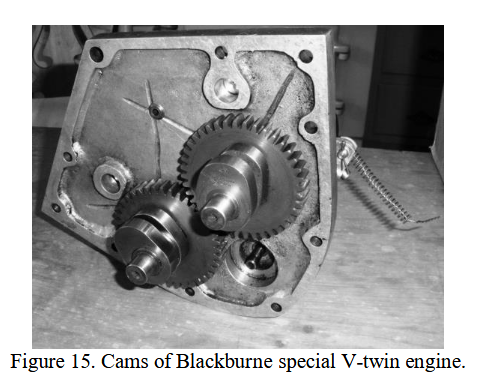
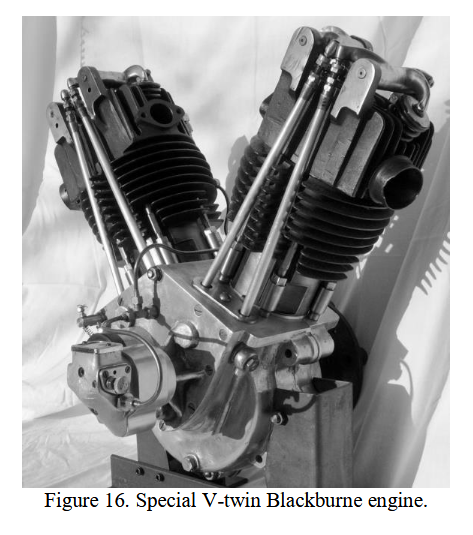
Twin Bowden carburettors were used, and a special (mirror image) cylinder
head produced for the left-hand cylinder (viewed from the front). The head for the
right-hand cylinder was common to the 500cc single cylinder Blackburne
motorcycle engine.
The engine was estimated to give 70bhp (52kW), but it was not
dynamometer tested in a naturally aspirated configuration.78 One engine survived
in a reconstruction of the famous pre-war Freikaiserwagen special until it was
destroyed in a crash in 1950. After use during the early 1930s in various three-
wheeler Morgan cars, this engine was adapted to power the hill-climb and sprint
special from 1937 until the car’s demise. Initially used in naturally aspirated form,
it was later supercharged. The Freikaiserwagen special was one of the most
successful ever constructed. In June 1949 the car broke the record at Shelsey Walsh
hill-climb, in a time of 37.35 seconds.79 The previous record, set by Raymond
Mays in a two litre ERA, had stood since 1939.
The Carriage Trade
The 1930s saw Harry Hatch embarking on an altogether different project for
Blackburne, namely the development of an in-line six-cylinder passenger car
engine. Noel Macklin produced Invicta cars, noted for their flexibility and
performance, particularly the 41/2 litre model. However, such cars were extremely
expensive, chassis price alone being £750, while a complete car in open two or four
seater form was £950.80 In the early 1930s, recession forced economies, yet
customers still wanted the ‘big car feel’, and a small six-cylinder engine seemed to
fit the bill. Responding to these pressures, Macklin looked for a suitable engine for
a smaller Invicta. Harry Hatch produced speculatively for Macklin a six-cylinder
1498cc single OHC engine,81 which was used in the Invicta 12-45 model launched
in 1932. However, chassis weight was high, and engine output modest, resulting in
an unimpressive performance inconsistent with the reputation of previous models.
It is believed that about 200 of these cars were sold.
In designing the small six-cylinder engine for the Invicta, Harry Hatch was
breaking new ground for Blackburnes. The first challenge lay in selecting a
suitable bore and stroke. Taxation for cars, unlike motorcycles, was based on
piston surface area, favouring a small bore to keep annual taxation to a reasonable
level. Hatch chose dimensions of 57mm bore and 97.9mm stroke, giving an RAC
rating of 12.09 hp, and annual road tax of £12. The cylinder head of the new engine
drew from motorcycle experience, providing one port for each cylinder, with
inclined overhead valves and a generally hemispherical combustion chamber
shape. As usual with Hatch’s designs, the bottom end was rugged and strong. A generously sized oil pump circulated oil through a filter, then via crankshaft drillings to big end and main bearings. The four main bearings were a combination
of ball and/or roller at each end and two white metal bearings between cylinders 2-
3 and 4-5. Steel connecting rods with white metal bearings were employed,
together with domed light-alloy pistons.
The overhead camshaft was driven by chain, controlled by a Weller spring-blade tensioner. The valves were operated by
rockers with roller followers running directly on the cams. The camshaft and valve gear were lubricated from a crankcase oil feed, via the relief valve mounted on the cylinder block. A light alloy crankcase supported the cast iron cylinder block and head; both sump and cam cover were also of light alloy. Despite efforts to save weight, the complete unit weighed over 150kg (330lb). Figure 17 shows a cross section of the single OHC Blackburne six-cylinder engine.

The design of the cylinder head was unusual with almost vertical exhaust valves, while inlet ports were horizontal, with steeply inclined inlet valves. This arrangement resulted in a wedge-section head casting, with exhaust ports higher than the inlet ports. The outcome was a sloping top to the cam cover, and the curious illusion of a ‘banana-shaped’ engine. Figure 18 shows the crankshaft and connecting rod assembly from the Blackburne single OHC six-cylinder engine. At least two different crankshaft designs exist for this engine. One featured bolt-on balance weights, while the type depicted shows balance weights integral with selected webs. Figure 19 shows the SOHC engine complete apart from starter motor.
The front engine mounting, crankshaft vibration damper, and the oil filter- housing cast into the crankcase are all visible in this view. This engine was described as the 12-45 by Invicta. A supercharged version described as the 1290 was also available. The vane-type supercharger was driven from the extended nose of the crankshaft, drawing through an SU carburettor, and feeding the inlet ports
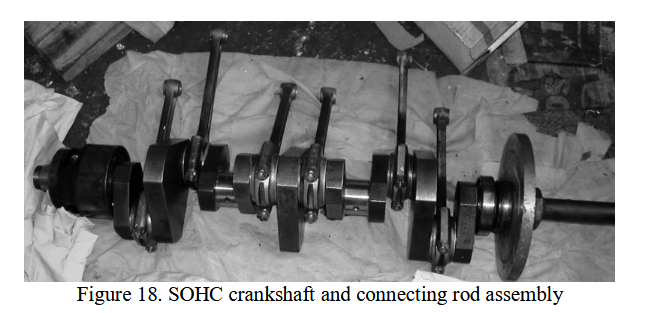
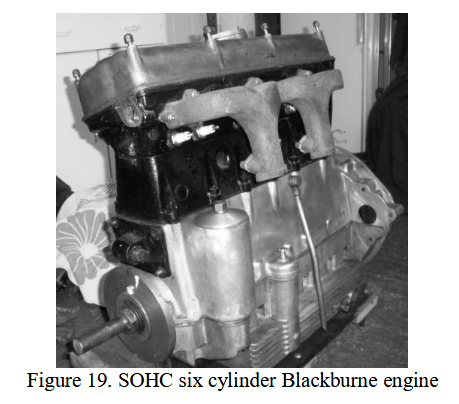
through a heavily finned manifold. Compression ratio for the supercharged engine
was 4:1 with boost pressure believed to have been 12psig (827mbar).
The Twin OHC Engine Discussions with AFN, manufacturers of the Frazer Nash sports car, led to
production of a twin camshaft variant of the Invicta engine.83 For the Frazer Nash
installation, Hatch reworked the entire design, although many similarities existed
and some parts were common to both engines. The crankcase and sump were very
similar, if not quite identical, but the crankshaft and connecting rods, cylinder
block, head and valve gear were all different. Figure 20 shows the crankshaft from
the twin OHC engine.

Figure 20. Twin OHC engine crankshaft. The crankshaft, with mostly circular webs, was very substantial and weighed
some 34kg (75lb) without bearings. The camshaft drive arrangements were similar to the SOHC engine, with a duplex chain driving the exhaust camshaft by intermediate sprocket, itself driven from a gear meshing with another keyed on to
the crankshaft. The two camshafts were geared together, and thus turned in opposite directions. Lubrication arrangements were also similar for both engine designs. Figure 21 shows the valve train and camshaft drive for the twin cam engine. Cylinder head design was altogether better on this engine than on the SOHC unit, with symmetrical, widely angled valves providing good breathing. The hemispherical combustion chambers employed a central 14mm sparking plug. The
rockers operating the valves and roller camshaft followers are also visible in Figure 21. Most twin-cam engines were produced with 60mm bore, giving a capacity of 1667cc. Some owners wanted engines compatible with 1500cc competition limits, resulting in a 57mm bore as for the earlier single OHC engine.
Triple carburettors were initially used, although later engines were fitted with twin carburettors. The cylinder head was fixed to the block with downward facing studs, the nuts accessed via recesses in the block. While this design reduces accessibility, it has the advantage that the head can be removed from the block with camshafts and valves in place, without disturbing the timing or upsetting tappet clearances. The camshaft drive gears are not keyed to the camshafts, but rely on a taper and lock nut design. There is no formal timing as such for this engine; Burney and Blackburne used to adjust the valve timing when the completed engine was on test, to satisfy the claim that each engine would produce 75bhp (56kW).
However, it is possible to give a nominal timing, used by many owners over the
years, as shown in Table 4 below.

Frazer Nash production was never very great, and in total only about 28 cars were fitted with the twin OHC Blackburne engine. A few are believed to have been used in Invicta cars, but even including these, total production is estimated at about
thirty units, of which perhaps twenty survive. The engine used light alloy connecting rods, which became brittle with age, leading to failure. This problem accounted for the destruction of a number of engines, but replacement with steel
connecting rods removes almost the only significant weakness in the design. As a result, these engines are now valued and sought after. Figure 22 shows the twin OHC Blackburne engine installed in a 1934 Frazer Nash car. The single OHC
version of the engine can be seen in the background.
During the years of its production, broadly 1933-1936, Burney and Blackburne appeared to be making almost constant changes to the twin OHC unit, apparently no two surviving engines being exactly alike. Crankcase, sump, cylinder
head, cam cover, both intake and exhaust manifolds, crankshaft and water pump all show changes during production. With such low production numbers, these changes perhaps represented optimisation as design stabilised, but this approach
was inconsistent with profitable operation.
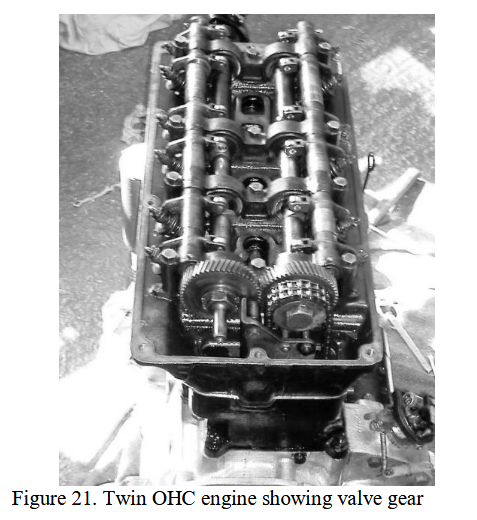
The Mechanical Marvel
In 1933, Harry Hatch collaborated with Eric Walker of Excelsior to produce a 250cc single cylinder Blackburne racing engine for use in Excelsior’s Light-weight TT entry. This interesting design used four valves arranged radially in the cylinder The head, giving a part-spherical combustion chamber. Twin carburettors and twin exhaust pipes were employed; their respective valves controlled by inlet and exhaust camshafts each operating one pushrod. On top of each pushrod sat a piston housed in a bronze bush. The upper surface of the piston operated a pair of rockers,
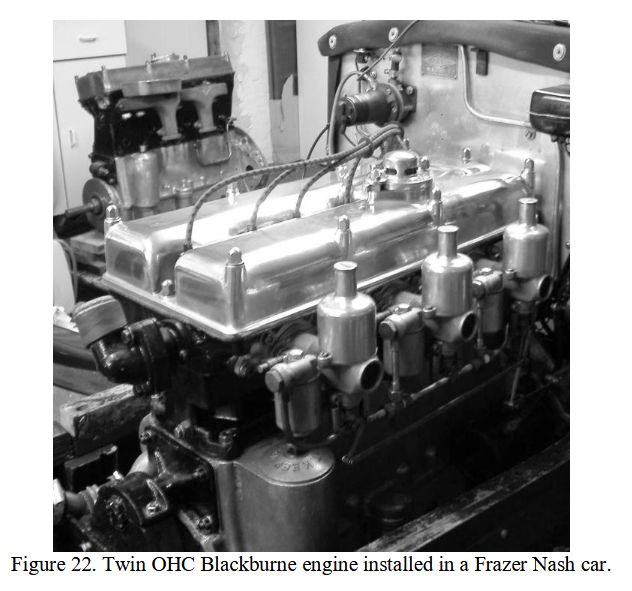
one for each valve.87 The Hiduminium connecting rod employed a needle roller big end bearing, the crank employing internal flywheels. This sophisticated andcomplex design was rapidly named the ‘mechanical marvel’, a title that it has worn
ever since. The engine was produced just before the 1933 TT race, and reportedly produced 25hp (18.7 kW) on test resulting in a lap speed of over 90mph at Brooklands.88 In the TT race itself, the engine enabled Sid Gleave’s Excelsior to win the Lightweight race at 71.59mph, with a fastest lap speed of 72.62mph.89 The engine was a pure racing unit and was not put into production. In fact it did not reproduce its winning form in later events, but it remains a milestone of ingenious design.
Engine Production Ceases
In addition to manufacturing Blackburne engines, Gillett and Stephens had a contract to overhaul and test V-12 Liberty aero engines at the conclusion of WWI.
Through the 1920s this work grew to be a major activity, including the manufacturing of spares.90 Later, in 1934, the company manufactured aircraft undercarriages and hydraulic equipment, and in 1936, took on a large contract to make incendiary bombs in addition to aircraft work. The revenue from such contracts clearly exceeded that from producing engines for cars, motorcycles and cycle-cars, and by 1937, the management at Gillett and Stephens stopped producing Blackburne engines and turned the company’s entire effort over to military contract work.
This change marked the end of an honourable progression from a home-made single cylinder motorcycle engine at the dawn of the century to asophisticated high performance multi-cylinder sports car engine in the mid 1930s, with light aircraft engines and many record-breaking racing engines en-route.
Harry Hatch featured strongly in this process, and not long after production of Blackburne engines ceased; he left the company. After war service in research and development with the Air Ministry, he re-joined the motorcycle industry in the late
1940s, working until his death in 1954.

